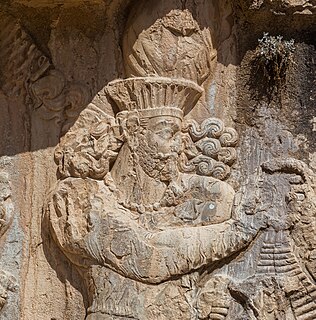
Hormizd IV, was king of the Sasanian Empire from 579 to 590. He was the son and successor of Khosrow I.

Yazdegerd II, was the sixteenth Sasanian king (shah) of Iran. He was the successor and son of Bahram V (420–438) and reigned from 438 to 457. His reign was marked by wars against the Byzantine Empire in the west and the Hephthalite Empire in the east, as well as by his efforts and attempts to impose Zoroastrianism on the largest religious minority within the empire, namely the Christians.

Yazdegerd I was the twelfth king (shah) of the Sasanian Empire, ruling from 399 to 420. He was the son of Shapur III (383–388). He succeeded to the Sasanian throne on the assassination of his brother Bahram IV in 399 and ruled for twenty-one years till his death in 420.

Bahram II was the fifth king (shah) of the Sasanian Empire from 274 to 293. He was the son of Bahram I. He was the first Sasanian ruler to have coins minted of his family. He also ordered the carving of several rock reliefs that unambiguously emphasizes distinguished representations of his family and members of the high nobility. In the east, Bahram II had to deal with revolts by his cousin Hormizd of Sakastan and brother Hormizd I Kushanshah. At the same time his empire was invaded in the west by the Roman emperor Carus, who may have briefly occupied the Sasanian capital of Ctesiphon. In Khuzestan, a Zoroastrian factional revolt had occurred. After making peace with the newly ascended Roman emperor Diocletian, Bahram II was capable of bringing peace to his domains.

Narseh was seventh king (shah) of the Sasanian Empire from 293 to 302. He was the son of Shapur I.

Boran was queen (banbishn) of the Sasanian Empire. She was the daughter of emperor Khosrow II, and the first of only two women to rule the Sasanian Empire; the other was her sister and successor, Azarmidokht. Various authors place her reign between one year and four months to two years.

Bānbishn was a Middle Persian title meaning "queen", and was held by royal women in Sasanian Iran who were the king's daughters and sisters, and also by the consorts of the Sasanian princes that ruled parts of the country as governors. The full version of the title was bānbishnān bānbishn.

Bahrām Chōbīn or Wahrām Chōbēn, also known by his epithet Mihrevandak, was a nobleman, general, and political leader of the late Sasanian Empire and briefly its ruler as Bahram VI.

Kartir was a powerful and influental Zoroastrian priest during the reigns of four Sasanian kings in the 3rd-century. His name is cited in the inscriptions of Shapur I and the Paikuli inscription of Narseh. Kartir also had inscriptions of his own made in the present-day Fars Province. His inscriptions narrates his rise to power throughout the reigns of Shapur I, Hormizd I, Bahram I, and Bahram II. During the brief reign of Bahram II's son and successor Bahram III, Kartir was amongst the nobles who supported the rebellion of Narseh, who overthrew Bahram III and ascended the throne. During Narseh's reign, Kartir fades into obscurity, due not doing anything noteworthy as high priest.
Farrukhzad, was an Iranian aristocrat from the House of Ispahbudhan and the founder of the Bavand dynasty, ruling from 651 to 665. Originally a powerful servant of the Sasanian king Khosrow II, he, along with several other powerful aristocrats made a conspiracy against the latter and ended his tyrannical rule. They thereafter put Khosrow's son Kavadh II on the throne, whose rule lasted only a few months, before he was killed by a plague, being succeeded by his son Ardashir III, who was only after one year murdered by the rebellious former Sasanian army chief (spahbed) Shahrbaraz, who usurped the throne.

Bistam or Vistahm, was a Parthian dynast of the Ispahbudhan house, and maternal uncle of the Sasanian shah of Iran, Khosrow II. Vistahm helped Khosrow regain his throne after the rebellion of Bahram Chobin, but later led a revolt himself, which encompassed the entire Iranian East before being suppressed.

The Sasanian civil war of 589-591 was a conflict that broke out in 589, due to the great deal of dissatisfaction among the nobles towards the rule of Hormizd IV. The civil war lasted until 591, ending with the overthrow of the Mihranid usurper Bahram Chobin and the restoration of the Sasanian family as the rulers of Iran.

The Sasanian civil of 628–632, also known as the Sasanian Interregnum was a conflict that broke out after the execution of the Sasanian king Khosrau II between the Sasanian nobles of different factions, notably the Parthian faction, the Persian (Parsig) faction, the Nimruzi faction, and the faction of general Shahrbaraz. Rapid turnover of rulers and increasing provincial landholder power further diminished the empire. Over a period of fourteen years and thirteen successive kings, the Sasanian Empire weakened considerably, and the power of the central authority passed into the hands of its generals, contributing to its fall.

Sukhra was an Iranian nobleman from the House of Karen, who was the de facto ruler of the Sasanian Empire from 484 to 493. He was active during the reign of shah Peroz I, Balash and Kavadh I. He is often confused with his father Zarmihr Hazarwuxt and son Zarmihr Karen.
Shapur IV, was king of Persian Armenia from 415 to 420, who briefly ruled the Sasanian Empire in 420.

The Sassanid Empire or Sassanian Dynasty is the name mused for the Persian dynasty which lasted from 224 to 651 AD.

Wahnam was an Iranian aristocrat who played a key role in accession of Bahram III to the throne of the Sasanian Empire in 293. His efforts eventually proved fruitless, as a few months later he and Bahram III were forced to surrender to the esteemed Sasanian prince Narseh, who ascended throne and had Wahnam executed.






















